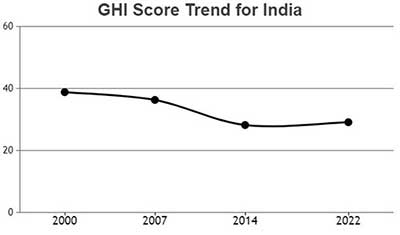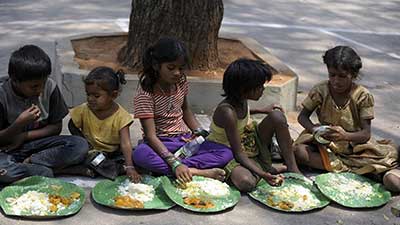Date: 05/12/2022
Relevance: GS-2: Issues relating to the development and management of Social Sector/Services relating to Health; Hunger and Poverty related issues.
Key Phrases: Global Hunger Index, International Food Policy Research, Child wasting, Child stunting, Child mortality, Food Insecurity Experience Scale (FIES), Ministry of Statistics and Programme Implementation, UN Statistical Commission, UN Economic and Social Council.
Context:
- Recently, FAO released the Global Hunger Index 2022 and some allegations have been made on FAO’s methodology for computing the GHI.
Key Highlights:
- India ranks 107 out of 121 countries on the Global Hunger Index 2022.
- After the release of the Global hunger index 2022, There were some allegations made on FAO’s methodology for computing the GHI by the Chairman of the PM's Economic Advisory Council.
- Now these allegations have been clarified by a team leader of Food Security Statistics, Food and Agriculture Organisation of the United Nations.
Allegations on FAO:
- FAO tends to equate food insecurity with malnutrition and equate that
with hunger.
- With India’s subsidised food security schemes, hunger isn’t likely
to be a problem. Indeed, the National Sample Survey’s consumption
surveys showed almost every household, rural and urban, reported getting
two square meals a day.
- Therefore, the discourse should shift from hunger to malnutrition.
- With India’s subsidised food security schemes, hunger isn’t likely
to be a problem. Indeed, the National Sample Survey’s consumption
surveys showed almost every household, rural and urban, reported getting
two square meals a day.
- FAO presents the GHI (Global Hunger Index), with a self-proclaimed
peer-reviewed methodology.
- There are four indicators for GHI - under-nourishment, child
stunting, child wasting and child mortality.
- Since these are the indicators, it is not accurate to call this a hunger index.
- One-sixth of the weightage is attached to child stunting,
1/6th to child wasting, 1/3rd to child mortality and 1/3rd to
under-nourishment.
- The nomenclature of “hunger” is driven by under-nourishment, which is for the entire population whereas the indicators suggest mostly for children only.
- There are four indicators for GHI - under-nourishment, child
stunting, child wasting and child mortality.
- An increase in child stunting and child wasting is necessarily always
bad.
- Child and infant mortality has been declining simultaneously.
Surely, that’s a good thing.
- These are children who would otherwise have died. Now born, they are now likely to be under-weight, stunted and wasted, compared to the average and that will pull down the numbers. So an increase in child stunting and child wasting should not be considered always bad.
- Child and infant mortality has been declining simultaneously.
Surely, that’s a good thing.
- FAO data come through surveys, not from complete enumeration.
- FAO collected data through its own Food Insecurity Experience Scale
Survey Module, which has eight questions and administered to a sample
size of only 3,000.
- This contains serious errors in translation and a small sample size of 3000 only. Such errors can be due to incompetence, or they can be deliberate.
- FAO collected data through its own Food Insecurity Experience Scale
Survey Module, which has eight questions and administered to a sample
size of only 3,000.
Global Hunger Index
- About:
- It was created in 2006 and jointly published by Welthungerhilfe and Concern Worldwide using one of FAO’s statistics, among others, to compute its index.
- The Global Hunger Index (GHI) is a tool for comprehensively measuring and tracking hunger at global, regional, and national levels.
- Key Component Indicators:
- GHI scores are based on the values of four component indicators:
- Undernourishment (share of the population with insufficient caloric intake);
- Child wasting (share of children under age five who have low weight for their height, reflecting acute undernutrition);
- Child stunting (share of children under age five who have low height for their age, reflecting chronic undernutrition);
- Child mortality (mortality rate of children under age five, partly reflecting the fatal mix of inadequate nutrition and unhealthy environments).
- Based on the values of the four indicators, the GHI determines hunger on a 100-point scale where 0 is the best possible score (no hunger) and 100 is the worst.
- GHI scores are based on the values of four component indicators:
Key Finding of Global Hunger Index 2022
- Ranks in South Asia:
- India ranks 107 out of 121 countries on the Global Hunger Index in which it fares worse than all countries in South Asia barring war-torn Afghanistan.
- Prevalence of undernourishment:
- Prevalence of undernourishment has also risen in the country from 14.6% in 2018-2020 to 16.3% in 2019-2021.
- Child wasting rate:
- India’s child wasting rate at 19.3%, is worse than the levels recorded in 2014 (15.1%) and is the highest for any country in the world and drives up the region’s average owing to India’s large population.
- Child stunting and child mortality:
- India has shown improvement in these two indicators.
- Child stunting has declined from 38.7% to 35.5% between 2014 and 2022,
- Child mortality has also dropped from 4.6% to 3.3% in between 2014 and 2022.

- Worsening GHI score:
- India has shown a slight worsening with its GHI score increasing from 28.2 in 2014 to 29.1 in 2022.

Clarifications by FAO:
- Use of the Indian government’s official statistics in preparation of
The Global Hunger Index
- India’s ranking results from the use of the Indian government’s official statistics, the National Family Health Survey, which reveals the rates of acute malnutrition in children under the age of five to be among the highest in the world.
- The same official data source also confirms that disconcertingly high rates of child mortality and chronic malnutrition persist in India, despite clear progress in the past few years.
- Validation of Indicator FAO uses to measure Food Security, the
prevalence of Undernourishment
- This indicator was scrutinised and approved by countries through the UN Statistical Commission and the UN Economic and Social Council in 2015 to monitor the UN’s SDGs.
- Prevalence of undernourishment is not only simply based on survey
data collected by FAO using the Food Insecurity Experience Scale (FIES)
- It is computed using data on national food balances and consumption
at the household level.
- The most recent food consumption data available for India is from 2011, when the results of the 68th round of the NSS were released.
- Regrettably, FAO does not have access to more updated data, including the results from the 75th round of the same survey on consumer expenditures conducted in 2017-2018, which is not publicly available.
- It is computed using data on national food balances and consumption
at the household level.
Conclusion:
- All of the methodological details regarding the way FAO measures food security are public knowledge and explained every year in the technical notes of the UN’s annual food security and nutrition report and FAO’s data and statistics website.
- FAO has been actively collaborating with the Ministry of Statistics and Programme Implementation to include FIES data into official national data collection initiatives and to align the national SDG indicators to the global SDG monitoring framework.
- FAO is ready to continue working with the government of India to strengthen food security statistics and achieve the common mission of a sustainable and food secure world for all.
Source: IndianExpress
Mains Question:
Q. What are the major allegations made on FAO’s methodology for calculating the Global Hunger Index? Also, state the clarifications given by FAO. (250 Words)








